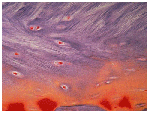Histology look-a-like #25
Pacinian corpuscles v Xibalba (from the movie “The Fountain”)
Pacinian corpuscles are one type of mechanoreceptor found in the body. Located in the skin they detect pressure and vibration.
This is in complete contrast however to the Mayan underworld ruled by death Gods and their demon buddies. Depicted here in the movie The Fountain as the Orion nebula.
According to The Sacred Book of the Maya: The Great Classic of Central American Spirituality, 2007, (translated by Allen J. Christenson), the residents of this terrifying place are the Lords of Xibalba, namely, Hun-Came (One Death) and Vucub-Came (Seven Death). Their cronies are demons who work in pairs to oversee various forms of human suffering .
Xiquiripat (Flying Scab) and Cuchumaquic (Gathered Blood) like to sicken people’s blood;
Ahalpuh (Pus Demon) and Ahalgana (Jaundice Demon) make it thier mission to make people’s bodies to swell up;
Chamiabac (Bone Staff) and Chamiaholom (Skull Staff) do their bit for the environment by turning dead bodies into skeletons;
Ahalmez (Sweepings Demon) and Ahaltocob (Stabbing Demon) promote health and safety in our homes by hiding in the unswept areas of people’s houses and stabbing them to death;
Xic (Wing) and Patan (Packstrap) have the very specific job of causing people to die coughing up blood while out walking on roads.
Perhaps even more terrifying is while editing this image (submitted by daydreamingwanderer – thanks ddw – this is awesome). The width of both images randomly came to span 666 pixels. Read into that what you will, but I couldn’t bring myself to change it. Somehow it seemed so fitting.
Moral of this story: There is a reason why your parents pressure (there’s the Pacininan link) you into cleaning your room when you are a kid. It seriously is for your own safety.
Thanks again to daydreamingwanderer for this fantastic submission!
i-heart-histo
x







